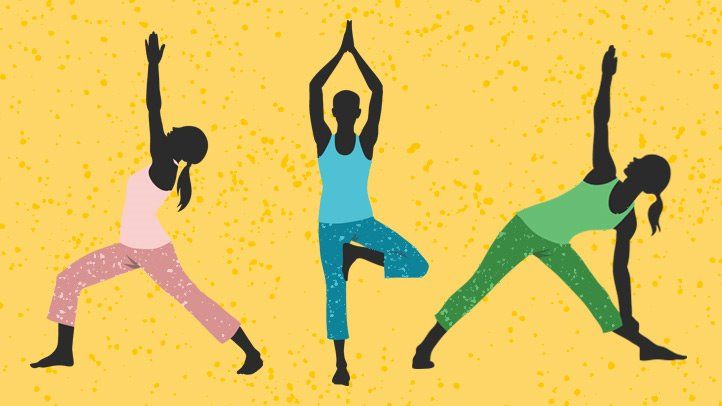
Yoga heart opening positions are a wonderful and effective way to increase your physical, emotional, and spiritual well-being. If your heart chakra is blocked, it will be difficult to forgive, love, or let go. This could lead to emotional instability. But if your heart is open, you'll feel feelings of warmth and love radiating within. You will also discover endless possibilities. Here are some easy poses that you can do at home. This article will demonstrate how to open the core of your being.
The American Heart Association recommends that you exercise at least 30 minutes each day to reduce your risk of developing cardiovascular disease. The AHA recommends that you do at least 25 minutes of aerobic exercise three times per week. This is 75 minutes total. Yoga and other yoga-type exercises are good for your heart. They're also easy on the joints. Yoga can actually increase your HRV, also known as Heart Rate Variability. This is an indicator of how your heart reacts in response to changes in your neuromuscular system. A high level of HRV is associated with a lower rate of cardiac arrhythmia.

Yoga for Heart is similar to a chair and is great for stimulating the heart. This pose is difficult to do well and requires focus and determination. Begin by standing erect, spread your arms out and face your palms upward. Keep your knees bent and keep this position for as long you can. Modifying the pose can be helpful if you have trouble holding this position.
Yoga postures help stretch muscles and increase insulin sensitivity, which in turn helps to control blood sugar. Meditation and breathing techniques can help lower blood pressure. These exercises are also beneficial for people with heart disease. Yoga postures are good for improving cardiovascular health. To improve your health, you can do asanas as well as asanas. What are you waiting to do?
One of the most vital parts of the body is the Yoga heart. It helps regulate the flow of blood and improves the circulatory system. Yoga practice has been shown to lower the risk of stroke. By strengthening the heart, it can also prevent a stroke. The Yoga Heart can help to prevent strokes. Although the practice cannot replace a regular medical treatment, it can help to prevent strokes.

Research on yoga's benefits to the heart has been conducted in recent years. It has been shown that yoga can improve flexibility, improve energy, and improve mood. There are many other benefits that it can bring to your body. For example, it improves your flexibility and reduces stress. It's good for your heart. It is a great way to keep your mind and body fit. It promotes a healthier heart.
FAQ
Which exercise is best for men
It depends on what you're looking for. Cardio workouts can help you lose weight faster than strength training.
On the other hand, if you just want to build muscle mass, then strength training is better since it increases lean body mass.
Both types can be used to improve your overall wellbeing.
If you are looking to lose weight quickly, I recommend HIIT or sprint-interval training. This type is great for burning fat fast by increasing metabolism. This type of training also increases your endurance, allowing you to train even when you are tired.
Do I have to do it every day?
No! You should do at least 30 mins of moderate-intensity activity 5 days per week. That could mean walking fast enough for you to get slightly out of breath and biking hard enough for you to sweat.
What does butter do for men?
Butter is one of many good sources of saturated fats. This type fat is great for your skin and hair. It also helps you build stronger bones.
Vitamin K, found in butter is an antioxidant that prevents bleeding from cuts. Vitamin K is combined with vitamin C to prevent bruises.
Butter is rich in minerals such as calcium, potassium, and phosphorous. These elements are good for teeth and bones.
Butter has its limitations. Butter is high in cholesterol. A few studies have shown that too much cholesterol can increase the risk of developing coronary disease.
Also, butter is high in saturated fat, contributing to obesity and increased cholesterol levels.
However, if you must have butter, try spreading it on bread rather than dipping it into soup or salad. Bread absorbs oil more than pasta or potatoes.
What does milk do for men?
The next time you buy milk, think about what else you could use it for. It may be a good idea to reduce your coffee intake.
Children and adults both have found milk to be beneficial. Milk is rich in nutrients for children, including vitamin D and calcium.
It aids in digestion, strengthens bones, and promotes weight loss. Dairy products are more beneficial for adults than any other food.
Milk is also rich in lactose, so people who cannot digest this sugar easily can enjoy its benefits without experiencing stomach problems.
You can drink more milk than you would soda or juice. Your teeth and bones can be strengthened by drinking milk rich in vitamin D and calcium.
Plain low-fat milk can be used to make yogurt if you don’t like the taste. Yogurt is a great alternative to milk since it is lower in calories and higher in protein.
Yogurt also has probiotics that aid digestion and increase immunity.
Try warm milk to help you fall asleep. Warm milk relaxes muscles, increases serotonin levels and helps you get a good night of sleep.
Are Cardio exercises good or bad for your health?
Cardiovascular exercise has many benefits. It improves blood circulation, strengthens your heart muscle, increases stamina, helps you lose weight, and gives you energy.
Cardiovascular exercise includes running, biking, hiking, swimming, tennis, basketball, soccer, volleyball, football, etc.
It is important to keep in mind that cardio exercises should not only be performed at a high level of intensity, but also at low levels. Doing this could lead to injury.
The cardiovascular exercise should only be performed if you feel good.
Never push yourself past your limits. Otherwise, you could end up injuring yourself.
It is important to warm up before you begin any cardiovascular exercise. Next, increase your intensity gradually.
Always listen to your body. If you feel pain during cardiovascular exercise, stop immediately.
It is also advisable to rest after a cardiovascular workout. This allows your muscles to recuperate.
Cardiovascular exercise is an important part of losing weight.
It is the most effective way to burn calories and reduce belly fat.
Do weightlifting burn fat faster?
You can lose more fat by weight lifting, but only when you do it in conjunction with cardio.
For the best results of weightlifting, do it after cardio exercises.
If done correctly weightlifting can raise your heart rate, oxygen consumption and help you lose weight.
If you don't mix it with cardio, your body won't notice significant changes.
Statistics
- An estimated calorie range for moderately active adult males falls between 2,200 to 2,800 calories per day, depending on age. (eatright.org)
- 10 pounds in a month is likely during a lean bulking phase, especially for beginners. (muscleandstrength.com)
- By John Thompson Take a whopping 38% off a set of PowerBlock Pros. (menshealth.com)
- Candidates and applicants must pass all four tests at 70% (minimum level) to graduate from Basic Deputy U.S. Marshal (BDUSM) Training. (usmarshals.gov)
- According to the American Heart Association, blood pressure should be checked at least once every two years, beginning at age 20. (my.clevelandclinic.org)
External Links
How To
How can I exercise to burn fat?
Exercise burns calories by increasing metabolism and oxygen consumption.
If you exercise with moderate intensity, you can safely lose weight.
These tips can help you to burn fat while training:
-
Cardio exercises like walking, running (or jogging), swimming, cycling, running, and/or elliptical training are all good options.
-
Exercise for 30 minutes three times per week.
-
Add strength training to your workouts if you are looking to lose more weight.
-
Avoid intense workouts. You can build muscle and not break down muscle tissue.
-
During exercise, drink plenty of water. Water helps flush out toxins and keep your body properly hydrated.
-
Choose low-fat protein shakes after working out. Protein shakes boost energy and repair muscle tissue.
-
Eat smaller meals throughout the day, so you don't feel hungry between meals.
-
Don't skip breakfast! Skipping breakfast can lead to fatigue and sluggishness.
-
Take care of yourself mentally. Stressful situations can slow your metabolism.
-
Keep a positive attitude. Studies show that overweight people are more likely to be obese than those who perceive themselves as attractive.
-
Sleep enough. Insufficient sleep can make it more difficult to lose weight.
-
Stay active. Keep moving every hour.
-
Maintain a healthy diet. Eating right keeps you feeling full and satisfied longer.
-
Find relaxation methods. Your body won't release stress hormones that cause muscle tissue destruction if you have a tense mind.
A balanced diet is one that includes all of the essential nutrients required for growth.
Consider eating six small meals daily instead of three big ones. This gives your body more time to digest the food you eat.
You need about 500 milligrams of calcium daily to maintain strong bones. Calcium can be found as a dairy product such as milk, yogurt and fortified soy drinks, orange juices, cereals, breads, and cereals.
Calcium can be found in leafy green veggies, beans, tofu and nuts as well as seeds, nuts and cheese.
Vitamin D is essential for calcium absorption. It's found in fatty fish, egg yolk, and some fortified foods.
Vitamin E is important for skin health. Vitamin E can be found in vegetable oils as well as wheat germ oil, peanuts and almonds.
Your body requires zinc for normal immune function and wound healing. Zinc is found in seafood, oysters legumes meats, whole grains, whole grains and meats.
Zinc deficiency may cause fatigue, loss appetite, depression, and impaired immunity.
Consuming too much sugar can cause insulin resistance. This causes an increase in blood glucose levels. Insulin resistance leads to weight gain.
High levels of free radicals can lead to insulin resistance. Free radicals refer to molecules that contain unpaired electrons. They can damage cell membranes and other body parts.
Food additives, pesticides and herbicides, as well as preservatives, smoking and radiation are all sources of free radicals.
Free radical damage can cause cancer, heart disease and diabetes, as well as arthritis, asthma, and other diseases.
Antioxidants are essential for preventing free radical damage. Antioxidants protect against oxidative damage.
Vitamin C is found in citrus fruits and beta carotene is found in carrots.
Additional antioxidant nutrients include selenium and copper, manganese and zinc.
Selenium helps to protect cells against free radicals and oxidative stress. Selenium can be found in Brazil nuts and liver, kidneys, liver, kidneys, shrimp, cod, turkey and lamb as well as chicken.
Copper protects the brain and eyes as well as the lungs and red blood cells. Copper is found in shellfish, poultry, meat, and organ meats.
Manganese is essential for bone structure. Manganese can be found in brown rice and spinach as well as bananas, prunes raisins, oatmeal, lentils, and oatmeal.
Zinc helps with normal growth, reproduction, as well as wound healing. Zn can be found in lean cuts, white fish, poultry, eggs, and other foods.